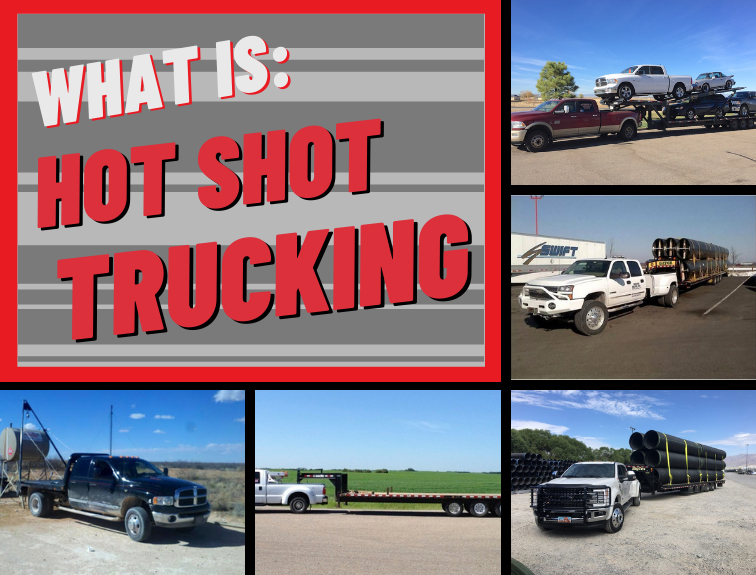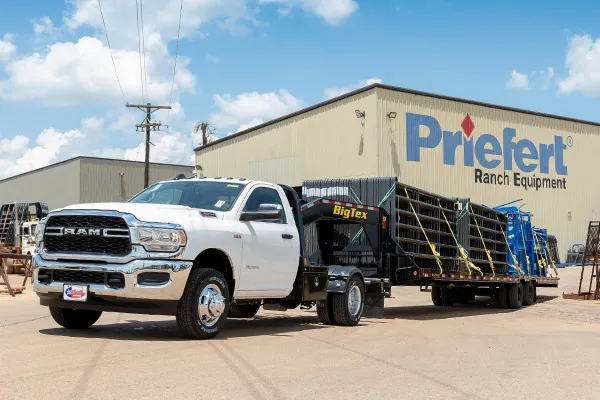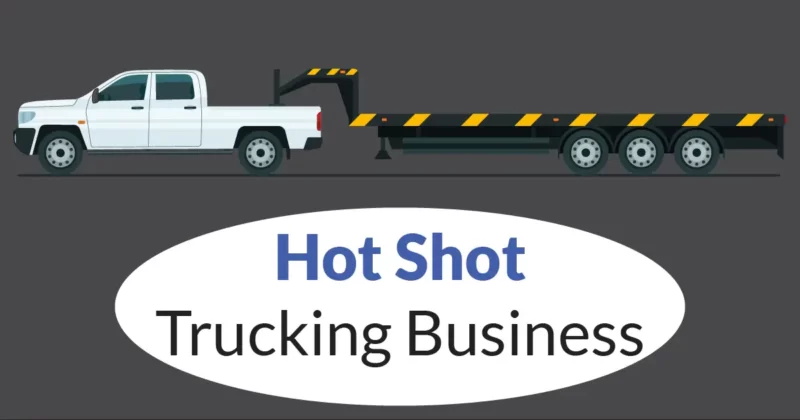Hot shot trucking involves hauling smaller, more time-sensitive LTL loads within a specific timeframe and usually to a single customer or location. Hot shot loads are usually delivered using medium-duty trucks that pull flatbed trailers. In this article, we discuss what hot shot trucking is. So let’s talk about all the “hot shot trucking” things.
What is Hot Shot Trucking?
Hotshot trucking is a truck driving service that involves delivering smaller than normal loads to a single location on a tight schedule. Requirements to successfully complete a hotshot transport may vary depending on whether the driver is traveling for short or cross-country trips. When companies have a tight deadline and need to deliver as quickly as possible, they usually hire capable truck drivers. Since normal trucking services can take several days to deliver, companies can ask for a good truck driver and sometimes deliver within 24 hours depending on the distance.
What Trucks Are Used For Hot Shot Trucking?
Hot trucking is gaining popularity among owner-operator truckers due to one major factor: You don’t need to own a traditional (Class 7-8) semi-tractor.
You see, heat shoot trailers – and whatever they carry (up to 16,500 pounds) – can be towed with a Class 3, 4, or 5 pickups.
While mid-size pickup trucks are considered non-commercial vehicles in the eyes of the law (Federal Highway Administration), hot test trucking is an exception to this rule.
The law allows drivers of Class 3-5 pickup trucks to pull heat loads as long as they do the following:
- Possess and maintain appropriate liability insurance and operating authority.
- Has a valid DOT identification number.
- Submit appropriate documentation to demonstrate ownership of the business.
- Comply with all federally mandated Hours of Service (HOS) regulations.
- A CDL is owned when moving pickup trucks and loading trailers with a gross vehicle weight rating (GVWR) greater than 26,000 pounds.

Advantages of Hot Shot Trucking?
There are plenty of reasons to take advantage of hot trucking capabilities where it fits your supply chain. The cost savings, visibility, and ability to help you meet tight delivery schedules make hot shot trucking an effective solution for many shippers.
Let’s talk about each of these advantages.
1. Added Cost Savings
Incorporating hot trucking into your supply chain has the potential to lower your shipping costs by doing several things:
- Increase the number of trucking solutions you have to choose from.
- Provides the capacity you need without booking a full trailer.
1. Increasing Your Pool of Trucking Solutions
Typically, a thermal spray trailer is as capable of transporting cargo as a standard flatbed or step trailer. So opening up your freight to the possibility of hot transport increases the supply of trucking solutions to choose from.
And, in an industry with a pricing structure where the ratio of available trucks to their service needs is central, more choice is best. Being flexible about the types of equipment you allow gives you greater bargaining power, which in turn lowers your price.
Example: Say you need to transport a 10,000-pound skid steer from Kent, Ohio, to a customer in Cincinnati, a mature destination with outbound capabilities.
When looking for a solution, you’ll find that there are only three flatbed drives and two stepped deck drives in your area, all of which can transport your skid steer.
All of those drivers were looking for freight to Cincinnati — where they knew they’d get their next shipment — but since they only had five passengers to choose from, the bargaining power was in their hands.
That said, with five additional drivers authorized to pull hotspot shots near your location, adding those drivers to your selection pool will double your original supply.
In a series of excellent performances, you decide to consider a hot shot as well.
Now that you have 10 viable solutions, the price of shipping your cargo to Cincinnati has dropped significantly as truckers recognize their competitors and price their services accordingly.
2. Supplying The Capacity Needed Without Paying FTL Prices
Full-length (48-53ft) flatbed trailers and step trailers can be expensive, especially if you need to book the entire trailer but don’t have enough cargo available.
So, where applicable, using the capacity of a thermally sprayed trailer will save you money for the entire truck, tractor, and semi-truck driver. Since hot drivers don’t bear the cost of owning and maintaining a tractor, as well as the low fuel efficiency that comes with driving a Class 8 semi-trailer and towing a 53-foot trailer, they are able to offer their service at a more cost-effective rate.
2. Greater Visibility
Sometimes, when sharing trailer space for larger trailers, shippers cannot adequately track the progress and touchpoints of their cargo. This can lead to costly delays when the consignee is not prepared for the arrival of the shipment or is in distress when the shipment is late.
Visibility is an important cog in creating a smooth supply chain, and sharing trailer space with other shippers often hinders load-tracking capabilities.
Hot Trucking removes these barriers as each shipment has a dedicated truck, trailer and driver motivated to provide the highest level of service to a single shipper.
If your next shipment is less than 10 feet tall and weighs less than 16,500 pounds, consider using hot shipping. Those who do it best may become an integral part of your supply chain.
3. Ability to Meet Tight Timeframes
When delivery deadlines are fast approaching and the goods your customers are waiting for the need to be shipped, just look for hot trucking.
Due to the size and versatility of these trailers, long loading times (which often hinder the truck’s ability to stay on the timeline) and slow hauling are not problems with popular trucking solutions.
Compared to PTL and LTL services, transit times for 14,000-pound shipments on a hot shot are easier to predict and plan. Since drivers and trailers are dedicated to each shipment, other shippers do not have to be loaded and unloaded, so hotspot freight is much more efficient for time-sensitive shipments than PTL or LTL services.
On top of that, hot spray trailers are easier to get around town, more fuel-efficient on the road, and quicker to load and unload at each end than a 48- or 53-foot semi-trailer.
Therefore, where applicable, thermal jet trucking can be a very convenient solution for shippers with tight schedules, as they provide a solution to move their cargo quickly and efficiently.
See more about How To Get Your Trucking Authority?
Disadvantages of Hot Shot Trucking?
Under the right circumstances, thermal shipping is a great option for shippers who need a fast and relatively cost-effective shipping solution. That said, there are three main drawbacks to a hot run to be aware of:
- Cargo Capacity Restrictions
- A limited supply of popular truckers
- Hot test trailers often lack air suspension
1. Capacity restrictions
The Hot Trailer can only legally transport 16,500 pounds of cargo on its deck and can be up to 40 feet long. Therefore, for shippers who need capacity above these thresholds, thermal jet trailers are simply not suitable for their shipments.
The problem is compounded when you consider that the drivers of these trailers — and many others — don’t like putting unnecessary stress on their equipment by maximizing their capabilities.
As a result, finding a hot driver willing to fully load 16,500 pounds is often difficult.
2. Limited supply of Hot Shot trucks
Although hot trucking has undoubtedly become more popular in recent years and therefore more accessible, it is still a relative niche service.
In most cases, hotspot capacity is provided by one-person-owned operators without requiring the infrastructure of an entire fleet of trucks, trailers, and drivers.
For shippers, that means finding a heat-injected truck when and where it’s needed can be harder than a 53-foot flatbed or step trailer.
That’s not to say shippers can’t find quick solutions when shipping their cargo, just that it’s harder to find solutions because of limited supply.
3. Most hot test trailers lack air suspension
Most conventional-sized trailers (towed by Class 7 and 8 semi-tractors and 48 to 53 feet in length) are equipped with an air suspension system. The air suspension consists of valves, bags, and compression devices to keep the cargo safe from damage due to bumps, bumps, and shifting during transport.
Air suspension has become a staple of most trailer types, especially the more recent ones produced. As a result, many shippers prefer the convenience and peace of mind that air-suspension trailers bring to them.
That said, most hot test trailers don’t come with an air suspension system. Instead, the vast majority of trailers used for high-speed trucking come with leaf spring suspension, which doesn’t provide the same protections for the Frigate. While a leaf spring setup is capable of absorbing most road bumps, it is generally not as efficient as an air ride system, which requires electricity to operate.
Therefore, thermal spray cargo carries an additional risk of cargo damage, which you should be aware of.
What Do Hot Shot Truckers Do?

Hotshot truck drivers typically use utility trailers because most of their loads are not large, and they do Hotshot hauling jobs on demand, which means many of them are freelancers, own their own vehicles, and find work on their own. While there are some in-demand truck drivers who work for designated employers or trucking companies, these jobs are sometimes given to anyone who can do the job. Many truck drivers take these time-sensitive jobs because they are lucrative opportunities and pay well.
Popular truck drivers have their vehicles registered for business to meet legal requirements and avoid paying fines. Because many high-profile truck drivers are owner-operators, it’s important for them to manage their business logs, which include tracking the time between shipments, recording the distance they drive for shipments, and measuring their transportation the exact weight. The haul weight is especially important because states have various rules and regulations for hauling objects across state lines. Top truck drivers have a firm understanding of the laws, regulations, and requirements that agencies create for them to move their cargo.
Pros of Working As A Hotshot Trucker
- High pay rate
Businesses pay more for these tasks due to the urgency of hot trucking jobs. Hot truck drivers have the potential to earn higher wages than traditional truck drivers. A competent truck driver who manages his work schedule well and lives in a lucrative place is likely to make the most money in this type of position.
- Lower maintenance
The maintenance requirements of popular truck drivers are generally lower. Because they ship using their own trucks and utility trailers, their equipment requires less company-authorized service. If their equipment breaks down, advanced truck drivers may be able to repair it themselves. Lower maintenance requirements also mean more money for capable truck drivers.
- Work-life balance
Many of the in-demand truck driver jobs are on a local or regional scale. Therefore, they may not have to drive as far as they can to get a job done. This allows them to spend more time at home and enjoy their personal life. It also allows them to set their own schedule for choosing to accept jobs
Cons of Working As A Hotshot Trucker
- Compete
Many of the hottest trucking jobs are on a first-come, first-served basis. So there may be some competition among truck drivers trying to get a particular job. This is especially true for a job that pays well and doesn’t require long drives.
- Lack of benefits
Hot truck drivers are usually freelancers and therefore do not work for a specific business or company. As a result, a red-hot truck driver may not get the same company benefits and guarantees as a standard truck driver. Many in-demand truckers also manage their earnings themselves to make deductions and make sure they pay the expected amount of tax.
- Inconsistent work
Popular trucking jobs can be inconsistent because they are offered on an as-needed basis. A red-hot truck driver might manage their work schedule to ensure they have enough work to maintain their target income. Sometimes the demand for hot trucking jobs is cyclical, meaning more jobs are available at certain times of the year.
- Popular Truck Driver Average Salary
While their report shows that the average annual salary of truck drivers is indeed not as high as that of top truck drivers, the average annual salary for truck drivers nationwide is $65,904. Annual salary will vary by location, work experience, credentials, and employer.
How to Find Hotshot Trucking Jobs
Here are three steps to help you find hot trucking jobs:
1. Search for switchboards
The most common way to find hot trucking jobs is to search for pallets, which are basically forums for transportation and logistics professionals. On these billboards, companies post popular trucking tasks for drivers looking for fast freight. These boards allow them to get jobs fairly frequently with little to no hassle. There are a lot of loading boards online, so sometimes it helps to monitor a few of them to increase your chances of getting the shot trucking job you want.
2. Consult your supervisor
If you are a trucker with a real trucking service, you can ask your supervisor or manager about hot trucking opportunities. They may have connections with other professionals in the industry or may have the latest information on popular trucking jobs from other companies.
3. Join RSS Feeds
Joining a Really Simple Syndication (RSS) feed can help you stay on top of popular trucking jobs. An RSS feed is an application that allows you to receive updates and notifications sent directly to your phone when your website is updated with new posts. If you’re using a load board that offers RSS feed functionality, then you can sync its RSS feed code to the RSS feed app on your phone, so you’ll know instantly when a company publishes new hot trucking jobs on the load board.
Final Words
What is hot trucking? Hot trucking is not the same as express shipping, which usually involves a car shipping company, leaving vans, trailers, and even pickups waiting to get the job done. Rather than having fast-haul vehicles on standby, hot-haul jobs can be assigned to different drivers via load boards.
